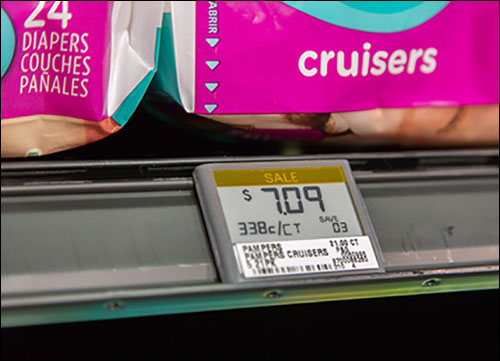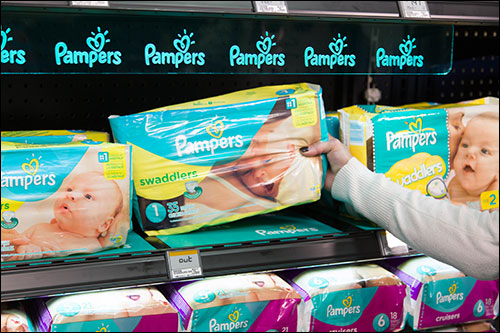At last month’s NRF Big Show, Panasonic System Communications Co., a division of Panasonic Corp. of North America, drew a great deal of attention for the electronic shelf label (ESL) system it demonstrated. The solution, known as Powershelf, now includes new Bluetooth Low Energy (BLE) beacon functionality, enabling retailers using the system to connect their customers with location-based content via a mobile app. The Powershelf was co-developed by Compass Marketing‘s Tagnetics subsidiary, and by Panasonic System Communications Co., which is also manufacturing, marketing and branding the product, according to Rance Poehler, the president of Panasonic System Communications Co. of North America. Panasonic began offering the Powershelf in 2013. “The Panasonic Powershelf is part of the company’s full retail technology solution offering,” he says.
The Powershelf is intended to enable stores to electronically update prices on LCD screens mounted on product shelves, as well as receive automatic notifications in the event that a shelf becomes empty, indicating a product needs to be restocked to ensure that sales are not missed. With the new version of the Powershelf, known as the Intelligent Retail Shelving Solution, an additional functionality allows retailers to utilize Panasonic beacons to send location-specific marketing and promotional messages to consumers as they walk past the shelves in store aisles.

Traditionally, beacons require battery replacement, which can be inconvenient for use on shelves at stores if hundreds of beacons are used. Electronic shelf labels can experience the same problem, since they require a battery to display data or receive updates. Powershelf employs inductive coupling for its power—a process by which electric current, flowing through a copper wire, creates an electromagnetic field that wirelessly flows to another conductor located about a half inch away. That second conductor, in this case, is connected to the rechargeable battery powering the shelf technology (consisting of a weight sensor, a microprocessor and an LCD screen). This wireless connection not only enables the battery to be recharged, but is also used for bi-directional data transmission, so that a label’s unique identifier or other information—such as a shelf being perceived as empty, based on weight sensor readings—can also be transferred between the back-end software and the shelf unit.
The inductive coupling technology has addressed several problems that burdened the electronic shelf industry in the past, says John White, the CEO of both Compass Marketing and Tagnetics. For one thing, he notes, it eliminates the need for battery replacement. Most electronic shelves on the market require that batteries be replaced—a process that can be both expensive and time-consuming at any store large enough to have hundreds or thousands of the labels installed on shelves. In addition, he says, traditional electronic shelves have not operated well in environments such as in freezers or refrigerators, because the labels cannot transmit data through a glass door well. The use of inductive coupling, White explains, overcomes this problem. In fact, he adds, in the case of freezers or refrigerators, the Powershelf technology can be connected to temperature sensors, and then transmit temperature data to a back-end server via the inductive coupling connection, which can pass through glass doors without a problem.
The Powershelf consists of the LCD screens or electronic paper displays mounted on a shelf rail—a strip of plastic that runs along the front edge of a retailer’s display shelves. Running through that rail is the copper wire that transmits data and power to the labels. The electromagnetic field created by the copper wire is used to charge each beacon’s battery.
Whole Foods Market has been the technology’s first user. The company has the Powershelf system installed at about 40 stores, to update prices from a central or remote location by simply changing the prices in its own management software. This prompts the next prices to be forwarded to the labels via the inductive coupling connection. If a weight sensor detects that a shelf is empty, the Powershelf label units send that status to the Whole Foods server, where its own software forwards that alert to personnel, advising them that a shelf needs to be restocked, as well as which products belong on that shelf.
This year, Panasonic has developed an additional function for the Powershelf: a BLE system including Panasonic beacons that can be attached to the rails on which the smart shelf labels are mounted. Whole Foods has expressed an interest in the beacon functionality, and all other potential customers discussing the Powershelf system with Panasonic have expressed interest in the beacon function as well. Whole Foods did not respond to a request for comment.
The beacon locks into the Powershelf rail in which the ESL is mounted on the store shelf. Stores can decide how many beacons they wish to install. White notes that it is important for a user to identify the quantity of messages that would be considered too many or too few to send to customers’ phone apps. “They have to decide, ‘How often do you interrupt a shopper?,'” he says.
Each customer would download an app provided by the store itself. With that app, consumers could then receive beacon transmissions and be sent relevant promotional data or coupons. For instance, if a shopper comes within range of a beacon in a store aisle, that individual could receive an alert (provided that his or her app is open) to indicate that a promotion is being offered on a particular product, such as a specific soft drink brand, while he or she pauses in the beverage area.
Whole Foods and other users would provide their own app to manage the beacon-based data, and would also supply location-specific data that could be linked to an individual shopper’s interests, based on that person’s previous purchasing behavior, or on the amount of time he or she spends in a specific aisle. While the retailer manages the app and the data regarding that app, White says, Panasonic would provide support for companies using the technology.
However, Poehler adds, Panasonic can also offer beacon-related content management, a software development kit and a hosted server, if a customer so requests. “Panasonic would utilize its large network of software partners,” he states, “to provide whatever software or SaaS [software-as-a-service] services a customer might need.”
Panasonic opted to include the beacon technology in the Powershelf system now because the use of BLE has become more commonplace since Apple released iBeacon as part of its iOS 7 operating system in 2013. However, White says, additional deployments and pilots will collect the data required to better understand how often consumers use the technology. “The concept of beacon technology is here to stay,” he says, adding that the “rules of engagement still need to be determined.”
White forecasts that the Powershelf could reduce the need for paper labels by such a factor that six trees per retail installation would be saved annually (based on the size of the Whole Foods store deployments.) Worldwide, he adds, there are 20 billion paper labels installed on shelves in stores, and those could all be transitioned to electronic labels, thereby saving many more trees.
“More than 70 percent of consumers in the U.S. are now using mobile devices as part of their path to purchase,” Poehler says. “Beacon technology can increase the connection between retailers, CPG companies and their customers, and improves the shopping experience with proximity-based, at-shelf advertising.”
Regarding his company’s existing and potential customers, Poehler says: “We are seeing tremendous interest in technologies like beacons that will be key to retailers looking to build a true omni-channel platform.”


